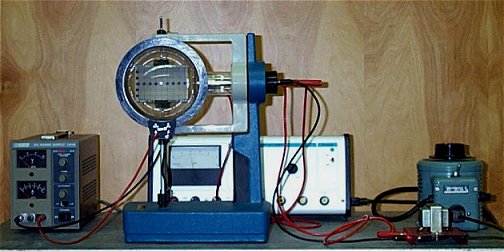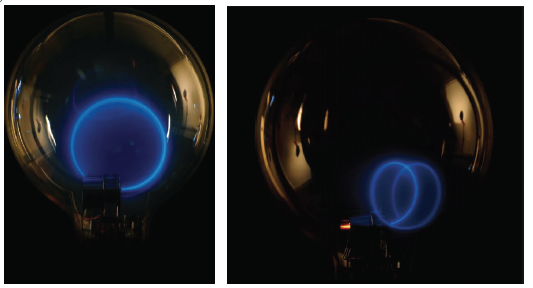| E&M > Magnetic
Fields and Forces > Force on Moving Charges |
DCS# 5H30.20 |
e/m TUBE

-
APPARATUS
| e/m tube |
214A |
| Helmholtz coils |
214A |
| 5 kV DC power supply |
214A |
| 6.3 V transformer |
214-01-D |
| variac |
202-08-H |
| low voltage DC power supply |
214-01-C |
| video camera |
202 |
DESCRIPTION
- This can be used to show that a
magnetic field perpendicular to the electron beam deflects the
beam along a circular path.

- To show crossed fields, or to
determine e/m, connect the deflection plates to the 2000 V DC
power supply (214A), adjust the voltage so the Coulomb force
on the electrons balances the magnetic force, and determine
e/m.
- NOTES
Helmholtz
coils: Connect jacks labeled "Z" on Helmholtz coils to
each other. Connect those marked "A" to the low voltage DC
power supply.
- Filament voltage: Connect
6.3 V transformer to the jacks at back of tube. Plug the
transformer into the variac. Turn the variac up to about
65. Light should be seen coming from the filament.
Do not exceed 6 V to the filament.
Accelerating
voltage:
Connect the 5 kV DC supply to the jack at the back of tube and
the jack along neck of tube which goes to the anode of the
electron gun. Turn the accelerating voltage up to about 2
kV.
- Vary the current to Helmholtz
coils to show deflection of the electron beam.
We also have the Pasco e/m tube, which can show a complete
circular path or helical path, but is not good for showing
crossed E and B fields. The images below are from the
Pasco Electron Charge-to-Mass Ratio instruction manual.

For Pasco tube: filament voltage = 6.3 VAC, accelerating
voltage 120-200 VDC, allow tube to warm up, current in
Helmholtz coils = 0-3.5 A (r = 15.8 cm, N = 130) or deflect
beam with permanent magnet. Radius can be measured using
the mirrored scale. Don't touch the glass tube.
Don't let the beam strike the glass for long periods of time.


